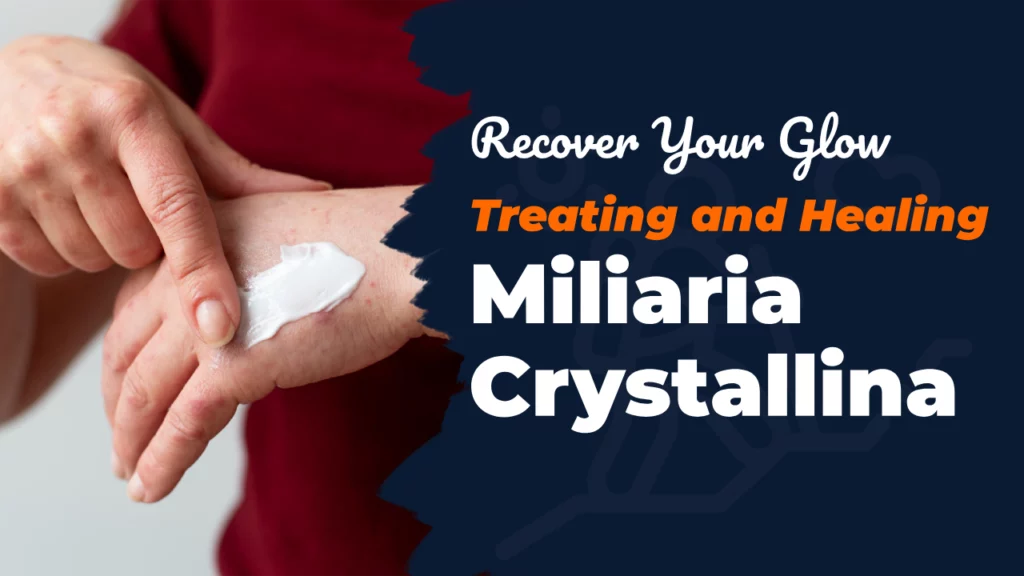Miliaria crystallina is a type of heat rash that causes tiny, clear blisters to form on the skin. It is also sometimes called crystal sweat, white heat, or baby dew. Miliaria crystallina is caused by sweat duct blockage in the outermost layer of your skin, the stratum corneum. This blockage traps sweat beneath the skin, forming the characteristic tiny blisters.
Key Highlights:
- Miliaria Crystallina is the formation of tiny (1-2mm), clear blisters on the skin. These are usually fragile and may break open easily.
- This heat rash most frequently affects newborns and infants, especially in hot and humid weather. However, overweight adults and those with fever can also experience it.
- Unlike other heat rashes, Miliaria Crystallina rarely causes itching or redness surrounding the blisters. This can help differentiate it from other skin conditions.
- In most cases, the rash goes away on its own within a few days if the person stays cool and avoids sweating. Cool compresses or calamine lotion may provide additional comfort.
- The best way to avoid Miliaria Crystallina is to stay cool and minimize sweating. This includes wearing loose clothing, staying in air-conditioned environments, and taking cool baths or showers.
Who Gets Miliaria Crystallina?
Miliaria crystallina is most common in newborns and infants, especially in hot and humid weather. It can also affect adults, particularly those who are overweight or have fever.
Symptoms of Miliaria Crystallina
The main symptom of miliaria crystallina is the formation of tiny, clear blisters that are about 1-2 millimeters in size. The blisters are fragile and can easily break open. There is usually no itching or redness associated with miliaria crystallina.
In some cases, miliaria crystallina can cause mild itching or discomfort. If the blisters break open, they may ooze a clear fluid.
Diagnosis of Miliaria Crystallina
Miliaria crystallina is usually diagnosed by a doctor based on its appearance. In some cases, a skin biopsy may be necessary to rule out other conditions.
Treatment of Miliaria Crystallina
Miliaria crystallina usually goes away on its own within a few days, as long as the person stays cool and avoids sweating. In some cases, a doctor may recommend using a calamine lotion or cool compresses to help relieve discomfort.
Prevention of Miliaria Crystallina
The best way to prevent miliaria crystallina is to stay cool and avoid sweating. This means wearing loose-fitting clothing made from breathable fabrics, staying in air-conditioned environments, and taking cool baths or showers.
Here are some additional tips for preventing miliaria crystallina:
- Avoid strenuous activity in hot weather.
- Drink plenty of fluids to stay hydrated.
- Use a fan or air conditioner to keep your surroundings cool.
Complications of Miliaria Crystallina
Miliaria crystallina is usually a mild condition that goes away on its own. However, in some cases, it can lead to more serious complications, such as:
- Infection: If the blisters break open, they can become infected with bacteria or fungi. This can lead to redness, swelling, and pain.
- Scarring: In rare cases, miliaria crystallina can lead to scarring. This is more likely to occur in people with dark skin.
Additional Information
Here are some additional details about miliaria crystallina:
- Miliaria crystallina is caused by a blockage of the sweat ducts in the stratum corneum, the outermost layer of the skin. This blockage can be caused by a variety of factors, including:
- Hot, humid weather.
- Overweight or obesity.
- Fever.
- Certain medications.
- The blisters associated with miliaria crystallina are filled with sweat. They are usually clear and painless, but they can occasionally cause mild itching or discomfort.
- Miliaria crystallina usually goes away on its own within a few days. In some cases, a doctor may recommend using a calamine lotion or cool compresses to help relieve discomfort.
Miliaria Crystallina serves as a crucial case study for exploring the role of research peptides in skin health. While the rash results from a mechanical blockage of the sweat duct within the stratum corneum, the fluid being trapped—sweat—is biologically rich. Sweat contains vital endogenous antimicrobial peptides (AMPs), such as Dermcidin, which are essential for the skin’s defense. A duct blockage not only disrupts thermoregulation but may also impair the delivery of these protective peptides, increasing the risk of secondary infections.
If you think you may have miliaria crystallina, it is important to see a doctor to rule out other conditions.
Conclusion
Miliaria crystallina is a common condition that can be easily prevented. By staying cool and avoiding sweating, you can help protect yourself from this annoying rash.
